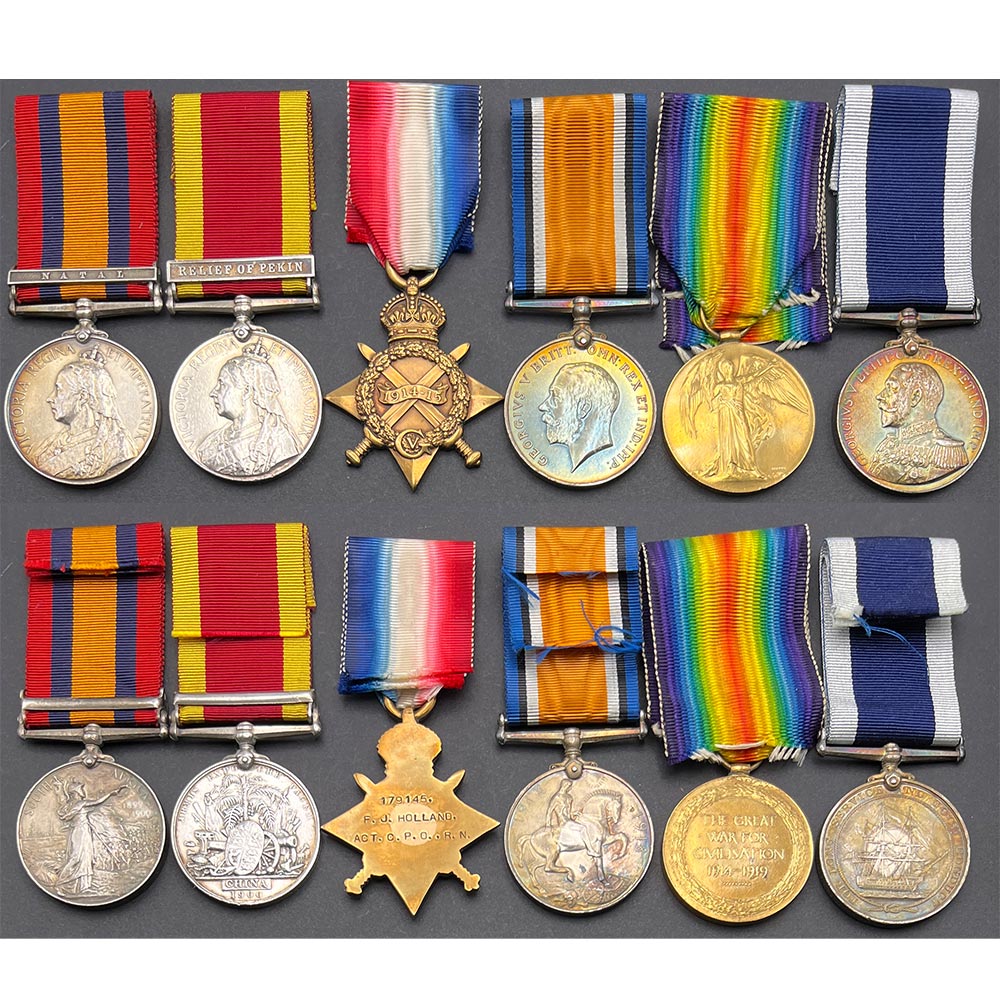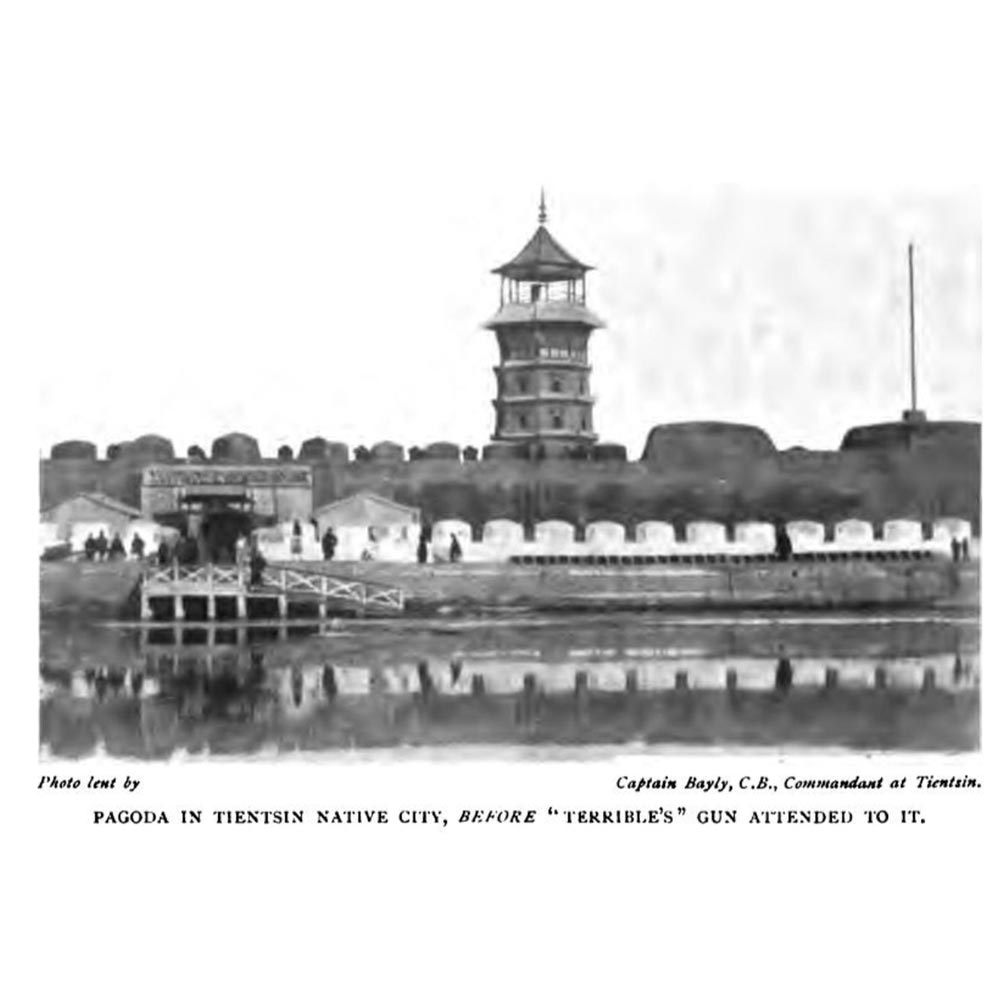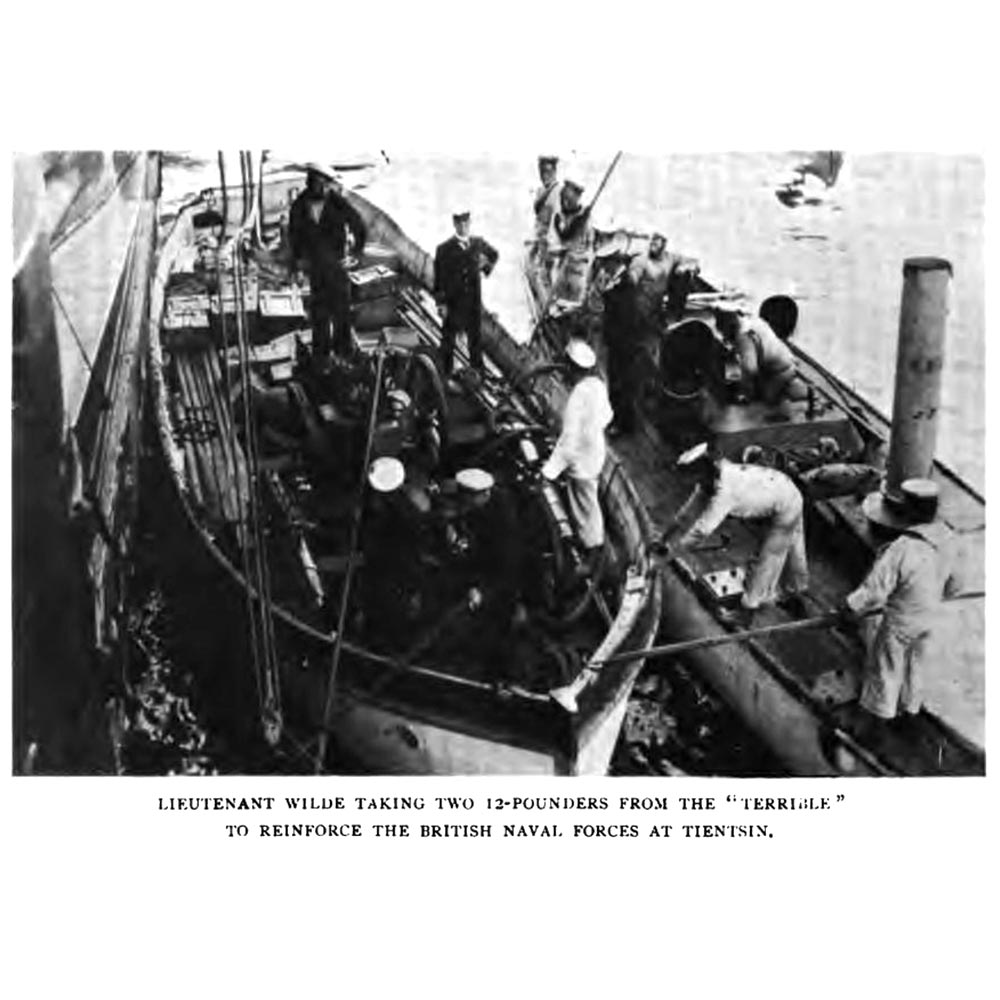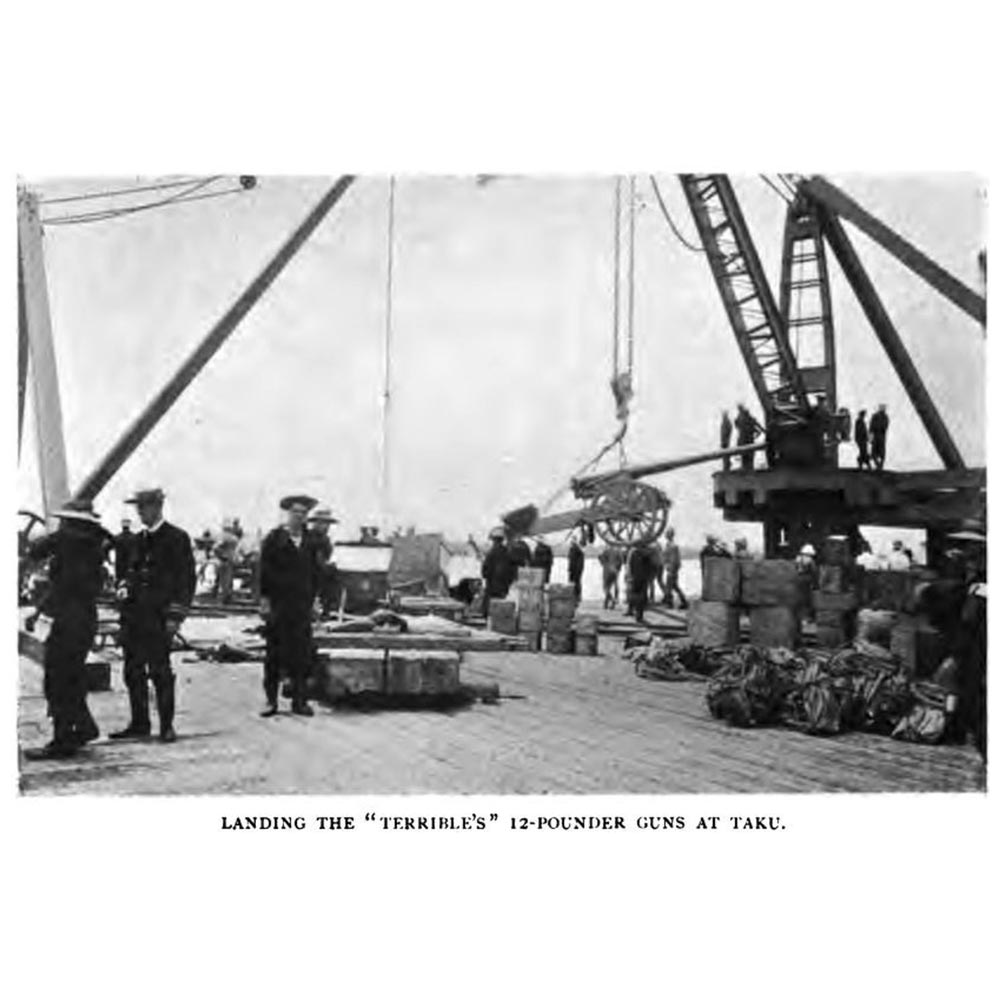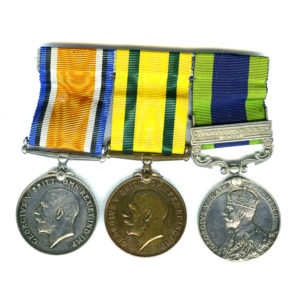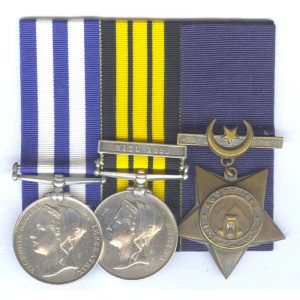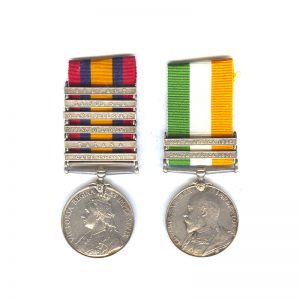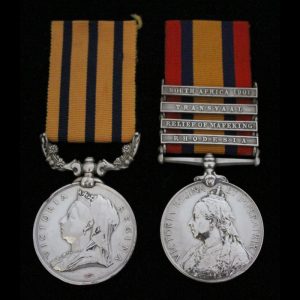Description
Queen’s South Africa, bar Natal, China 1900, bar Relief of Pekin, 1914-15 Star Trio, RN LSGC, 179145 Petty Officer Frederick James Holland, HMS Terrible.
China officially impressed: “F.J. Holland, H.M.S. Terrible.”
QSA officially engraved: “179145 A.B. F.J. Holland. H.M.S.” a good early issue with ghost dates to reverse.
1914-15 Star officially impressed: “179145 F.J. Holland, Act. C.P.O., R.N.”
British War and Victory medal officially impressed: “179145 F.J. Holland. C.P.O. R.N.”
RN LSGC officially impressed: “179145 F.J. Holland. P.O. 1 Cl H.M.S. Vernon.”
All medals correct and confirmed on the roll, including both “Naval Brigade” clasps to the QSA and China.
A rare complete group of 6, with double service as a Blue Jacket of the Naval Brigade in the Boer War and China War.
During the Boxer Rebellion in China Frederick served with the Gun Crew of No 4 12 Pounder gun in the Tientsin Defence Force and Relief of Pekin column.
The ship lent 4, 12 Pounder Cannons to the Army with their own crew to take part in the Relief of Pekin, (with a 5th that was sent to Shanghai with only 4 men), Each crew consisted of a Petty Officer Captain of Gun, a Leading Seaman and 13 Seaman to man the gun.
He earned his Natal clasp with the Naval Brigade as part of the Naval Transport Service (Durban), under command of Gunner “Mr Higgins”.
Notably during the First World War, he served on 3 Destroyers seeing a lot of service on Anti-Submarine Duties, leading to some success including sinking a Submarine.
He served on HMS Attack since before the outbreak of war, taking part in the Battles of both Heligoland Bight on 28th August 1914 and Dogger Bank on 24th January 1915.
He was also on board on 10th March 1915 when the Attack hunted down and successfully sank the German Submarine U-12, having been sighed by the Merchant Trawler “Man Island”, the Attack with her “sister ships” the Aeriel and Acheron set off in pursuit, Attack having first spotted the submarine and opened fire, being rammed and forced to surface by the Ariel, the destroyers then opened fire sinking the submarine, 19 men were killed and they rescued 10 survivors who managed to escape.
The U-12 was the first Submarine to have launched a Plane at Sea, and had claimed the sinking of HMS Niger in November 1914 and had also sunk the SS Aberdon on 9th March, which led to the sinking of her the next day having been spotted by a Merchant Ship.
Career Details:
Frederick James Holland was born on 18th March 1879, by the sea in Portsea, Hants.
He was a young “Errand Boy” when he first joined the Royal Navy, shortly after his 15th Birthday as a Boy 2nd Class on 25th April 1894.
During the period of the Boer War and 3rd China War, he served on board HMS Terrible from 13th September 1899 until 24th October 1902.
Notably during this time he was advanced from Able Seaman to Leading Seaman on board on 31st July 1902.
During his time on HMS Terrible he was detached for shore service in both the Boer War, where he earned his Natal Clasp whilst serving with the Naval Brigade.
Followed by The 3rd Anglo-China War, aka the Boxer Rebellion where he accompanied one of the ship’s 4 Guns that went into action with the Relief of Pekin column that captured Tientsin and pelieved Peking.
It would only take him 1 more year to rise up to Petty Officer 2nd Class on 1st April 1903 on HMS Duke of Wellington I.
Again a year later he was promoted up to Petty Officer 1st Class, 1st April 1904, on HMS Firequeen I.
He would earn this Royal Naval L.S. & G.C. Medal on 22nd March 1912.
A note on his papers reads: “Particulars of Service to the Royal Patriotic Fund Corporation.”
Frederick continued his service as a Petty Officer without break leading up to World War 1.
He first joined HMS attack on 12th December 1913 and would be on board for much action until 27th July 1915.
During his time on board, he took part in the Naval Battles of Heligoland Bight on 28th August 1914, as well as the Battle of Dogger Bank on 24th Januar 1915:
“On 24th January 1915, HMS attack commaned by Lt Cdr Cryil Callaghan, took part in the Battle of Dogger Bank as part of the 1st Destroyer Flotilla. In the final stages of teh abttle, at 11.20 with his Flagship, the Battle Cruiser Lion, seriously damaged, Vice Admiral Beatty called the Attack to come alongside. He then shifted his flag into her at 11.34 and used her to rejoin the rest of the battlecruisers, shifting again into the Princess Royal at 12.20″
He would also take part in the hunting down and sinking of the Imperial German Navy Submarine U-12, an account reads:
“On 10 March 1915, Attack, along with her sister ships Ariel and Acheron, was on a search mission near Aberdeen for a reported German submarine, prompted by the trawler Man Island.
Attack spotted U-12 at 10:10 and initiated firing. Ariel also spotted the submarine at 10:12, about 2 nautical miles away, and all three destroyers changed course towards it.
U-12 submerged and raised her periscope, which Ariel spotted at a distance of 200 yards. She attempted to ram, sighting the conning tower just before impact. Within two minutes, the submarine resurfaced for the crew to escape, but the conning tower hatch was jammed. Most of the survivors managed to escape through other hatches.
The destroyers fired upon the surfaced submarine, resulting in casualties among the escaping sailors. At 10:30, U-12 sank at approximately 56°15′N 1°56′W. 19 men lost their lives, while 10 survivors were rescued by the destroyers.
Ariel suffered significant damage to her bows and had to be towed to port.”
Not long after leaving he was promoted to Chief Petty Officer at HMS Victory on 1st July 1916.
He then served on HMS Oracle, from 4th August 1916 until 31st August 1917.
Notes on service during this time:
“The destroyer was engaged in anti-submarine warfare, although its effectiveness varied. On 19 August 1916, alongside its sister ship Penn, it was dispatched to eliminate the German submarine U-52, which had sunk the light cruiser Nottingham. Despite their efforts, the destroyers were unable to locate the submarine but successfully rescued many of the sailors.
On 18 January 1917, it participated in patrols referred to as “high-speed sweeps” in the North Sea with five other destroyers, utilizing paravanes, yet no submarines were spotted.
However, on 12 August, the destroyer achieved significant success. While patrolling alongside the light cruisers Birkenhead and Yarmouth, Oracle spotted a vessel on the horizon northwest by west, which turned out to be the submarine U-44, cleverly disguised with a sail. The destroyer swiftly approached the submarine, prompting it to dive and resurface multiple times in an attempt to evade capture. Despite the submarine’s maneuvers, the destroyer managed to ram it between the conning tower and stern after discharging four rounds of gunfire, all of which missed. Tragically, the submarine sank with no survivors.
This notable victory led to a shift in strategy by the Admiralty, which withdrew destroyers like Oracle from patrols and reassigned them to convoy escorts. This change proved more effective in preventing losses from submarines.”
Following a short stint at home for a month at HMS Victory.
He then joined HMS Ursula from 1st October 1917 until 31st December 1917.
After this he joined HMS Victory I from 1st Jan 1918 until 27th June 1918, at which time he was finally discharged having been invalided due to medical reasons.
At the time of his discharge he had been a Royal Navy Sailor since the age of 15, and was now 39 years old, having served for 24 years and left the service as a Chief Petty Officer.
